Aviator flies high as top U.S. luxury SUV
By John Gilbert
A good friend of mine, let’s call him Charley, had climbed the plateaus of journalism a few decades ago, and could afford the upscale family vehicle he had long craved. He wanted a midsize, luxury SUV, and he discussed his choices with me. After trying out several I recommended, he decided to buy a Lincoln Aviator.
Interesting choice, and not necessarily mine, but it checked all his boxes for being a cut above the more modest Ford Explorer, with some added features and classy appointments. Whenever I’d see him, he’d ask me about new vehicles I’d been test-driving, and then he’d tell me he still had his Aviator and loved it. I alerted him when the Aviator was discontinued, and when Lincoln itself seemed in jeopardy. Another decade has slipped past, and I’m not sure what Charley’s driving these days.
But when I see him next, I’m going to recommend the 2020 Lincoln Aviator in the strongest possible terms. The recalling of the old name on an all-new vehicle, on an all-new platform, stands for a lot more than just nostalgia, and if Charley liked the old one, he will love the new one.
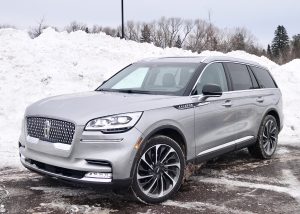
Far from a stereotypical pickup truck, the new Aviator radiates class even while confronting Minnesota snowpiles.
The Minneapolis-Saint Paul auto show runs through March 15 at the Minneapolis Convention Center. It’s an interesting year for the show, because it comes immediately after the huge Geneva Auto Show has been cancelled because of the worldwide threat of the Coronavirus and its warnings about avoiding major gatherings of people. We aren’t anticipating that major a threat in the U.S., but who knows? The upcoming New York Auto Show abruptly decided on March 10 to move its annual classic show to August 28-September 6, with media days August 26 and 27. Major pro sports teams are planning to eliminate crowds for the time being as well, but the Minneapolsi show goes on..
The Twin Cities show is attempting a made-for-U.S. specialty niche this year by putting on a “Truck Summit,” to explain and promote the nationwide swing to trucks over cars, which has reached amazing proportions in Minnesota, where reportedly 82 percent of sales are trucks or SUVs. The show will run through the first two weekends of March, and if you go, make it a point to check out the preponderance of trucks. In the process, you’ll notice the high level of sophistication in the interiors on virtually all manner of trucks.
Naturally, the array of Range Rovers sets a high standard for luxury appointments, and if you look closely at the SUVs in the Jaguar, Volvo, Mercedes, BMW, Audi, and Lexus — and even the new pickup trucks, particularly the Ram — it will not seem surprising anymore how much the price of those vehicles has increased.
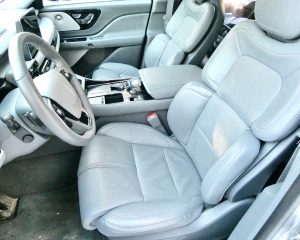
Difficult to say which is more impressive, the plush leather or the encapsulating comfort of the seat design.
But when you get to the Lincoln display, climb inside an Aviator. The first thing you notice is the rich leather bucket seat and how it encapsulates your body from head to knee. I’ve always praised Volvo for having the best seats in the industry, and maybe there’s a connection because Ford used to own Volvo, too. But the new Aviator bucket seats must now be ranked at the absolute top rung of any seat ratings.
There are something like 30 settings you can summon by switchgear to adjust your seat for optimum driving position. You can be excused, though, if you are tempted to stay in your parking space and take a short nap to fully take advantage of the comfort. Once you get the support right where you want it in the cushion, the lower back and the upper back, you can locate the switch that starts a massage process. It is a gently undulating thing, not the sort of massage to put you to sleep, but rather an invigorating stimulator that can enhance your awareness.
Base price of the Aviator Reserve with all-wheel drive is $58,700, but it’s difficult to resist some of the excellent options. The test vehicle had the luxury package, and options such as trailer towing, the sunroof, 22-inch machined alloy wheels, to augment blind-spot detection, evasive steering assist, auto high beams, active park assist, adaptive cruise, adaptive suspension, lane-keeping, drive mode selector, a 28-speaker Revel Ultima 3D audio, and readouts of posted speed limits on the dash or head-up display.
On top of all that, and the obligatory Sync3 navigation and connectivity items, a dynamic handling package aids stability and such features as a full rear console is handy between the rear buckets. All of that boosts the sticker price on the test Aviator to $76,310. That may seem outrageously high, but if you examine all that is included, and compare it to other top-shelf luxury SUVs and trucks, the Aviator appears to be worth the tariff.
The Aviator’s luxury starts long before you climb aboard, because the crisp contours of the accent sculpturing on both sides and the rear attract your attention and offer a pleasant aerodynamic appeal. From the front, the LED headlights, parking lights and foglights are all positioned in streamlined housings and surround the contemporary grille, which, thankfully, is understated in style and elegance. There are ingenious ways to turn the “puddle lights” and logo trim to make sure you remember what it is that you bought for a vehicle.
Opening the door on the test Aviator Reserve model, which was “silver radiance metallic” in color, avails you of the medium slate leather seats, which look much more than just inviting with their carefully crafted design. All the switches are within easy reach and have the anticipated redundant controls on the steering wheel. The console has room with the push-button shifter easy to get comfortable with. The sunroof is huge, and can let in a lot of sunshine even when closed for a winter day.
The large screen at the top of the center stack can carry several things at once. When you back up, you can summon the 360-degree surround view from up above to make sure there are no obstacles in the way of your movement. On top of the comfort and luxury, the Aviator drives easily, with stable cornering attitude and large doses of power for acceleration.
A 3.0-liter V6 is Eco-boosted to 400 horsepower and 415 foot-pounds of torque, programmed through a smooth-shifting 10-speed automatic transmission. The all-wheel-drive system is adjustable by modes for any type of driving, from blizzards to freeway cruising. It responds instantly to your throttle-foot input, although responding too eagerly can keep the fuel economy down around 17 or 17.5. The Aviator is heavy enough, so you can learn to appreciate the solidity more than the fuel efficiency.
The Aviator has larger siblings, such as the Navigator, but I find the Aviator to be the ideal size even for somebody who wants a large SUV. Open the rear seat and you see a couple more comfortable looking buckets, with a good amount of knee room. At a touch, the seat slides fore and aft to add more room, if you need it. Another touch and the backrest flops down, and the seat will tumble out of the way to allow easy access to the way-back, which is a third row seat. Room is less generous back there, but you’d want it mainly for young kids or agile teenagers.
There is also ample storage room, and you can greatly expand it by another switch, to fold the third-row backrests out of the way.
The Aviator weighs almost 6,000 pounds, but it drives smaller than that, with an agility and light-feeling demeanor that can make you forget you’re driving a hefty vehicle and drive it as though it’s a sporty machine. Maybe it’s time to reconnect with Charley, just to see what he and his wife are driving these days, and suggest making an auto show stop. Because if you want to take a flyer on a new luxury SUV, my pick is the Aviator.


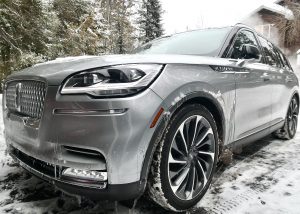


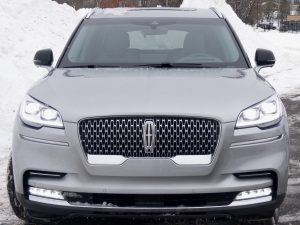
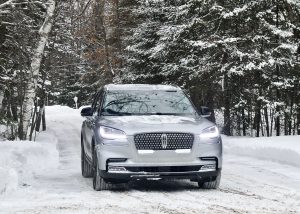
 John Gilbert is a lifetime Minnesotan and career journalist, specializing in cars and sports during and since spending 30 years at the Minneapolis Tribune, now the Star Tribune. More recently, he has continued translating the high-tech world of autos and sharing his passionate insights as a freelance writer/photographer/broadcaster. A member of the prestigious North American Car and Truck of the Year jury since 1993. John can be heard Monday-Friday from 9-11am on 610 KDAL(www.kdal610.com) on the "John Gilbert Show," and writes a column in the Duluth Reader.
John Gilbert is a lifetime Minnesotan and career journalist, specializing in cars and sports during and since spending 30 years at the Minneapolis Tribune, now the Star Tribune. More recently, he has continued translating the high-tech world of autos and sharing his passionate insights as a freelance writer/photographer/broadcaster. A member of the prestigious North American Car and Truck of the Year jury since 1993. John can be heard Monday-Friday from 9-11am on 610 KDAL(www.kdal610.com) on the "John Gilbert Show," and writes a column in the Duluth Reader.